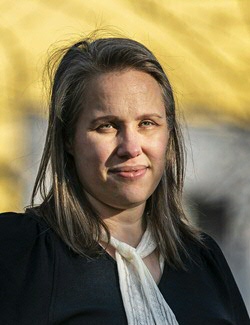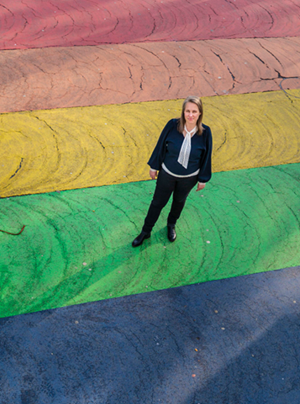The vulnerability of LGBT people

Why do sexuality and gender continue to be such sensitive topics within our society? Despite our liberal climate, members of the LGBT community face physical and mental health issues more often than others, even in the Netherlands. Laura Baams is looking into how this is possible.
Text: Jurgen Tiekstra / Photos: Reyer Boxem
It was during her psychology studies in Amsterdam that Laura Baams discovered that she was not only attracted to men, but also to women. This meant that her identity was different from what she had always thought: she was not ‘straight’ but ‘bi’. ‘In those days, I was looking for... well, for myself, really. I found it very interesting to discover that academic articles had been written about this topic. As a budding researcher it was nice to be able to read about myself.’ Baams went on to do PhD research at Utrecht University and became a developmental psychologist, focusing in particular on the mental health of LGBT adolescents. The abbreviation ‘LGBT’ (lesbian, gay, bisexual, transgender) can be expanded with the letters ‘Q’ (questioning or queer), ‘I’ (intersex), and ‘A’ (asexual or aromantic), and sometimes a ‘+’ as well.
HIV prevention
Both the LGBT community itself and the research field are relatively young. Baams explains: ‘The socioscientific research that started about 40 years ago mainly focused on HIV and HIV prevention, and therefore mainly on men who had sex with men – regardless of whether they identified as gay. Over the years, the perspective was expanded to also include women, and subsequently, more attention was paid to people’s identities, using terms such as “gay” and “lesbian”.’ The “B” was added when researchers found out that there were also people who had sex with both men and women, and that many people identified with the label “bisexual”. This resulted in the term “LGB”, even though gender diversity of course already existed in those days: gender diversity among LGB people, but also among heterosexual people. In addition, the community itself was aware that even though the various “letters” indicated various different experiences, they all had in common that they were rejected because of their sexual or gender identity, and that they were sexual or gender minorities within our society. Joining forces to achieve advocacy helped to create a bigger group.’
Verbal abuse
A paradox is at play for the LGBT community. Any outsider would think that in a liberal, individualistic country such as the Netherlands there is increasing space to be yourself. That we can all hang our flags out, because all minorities are free to express themselves. However, it is not quite as simple as that, says Baams: ‘I find it interesting to see that although societal acceptance of diversity in terms of sexual orientation and gender, as well as ethnicity, seems to be increasing, this is still not being translated into a decrease in violence or health problems. When you ask people: “How do you feel about this diversity?”, almost everyone will respond positively. But if you look at the experiences that LGBT people go through, things are not improving yet: people are still subjected to verbal abuse, they are still being beaten up, discriminated against at work, and bullied at school.’
Coming out sooner
Mental health issues do not appear to be decreasing either. ‘We see rather large differences between LGBT and non-LGBT groups when it comes to mental health – depression, anxiety, suicidal tendencies. These issues are expressed in a higher degree of drug use, and in the long term even in physical health problems, which appear to be related to this drug use or those prior mental health issues. I think we are dealing with two issues here. Firstly, the increased societal acceptance encourages young LGBT people to come out of the closet sooner, making them vulnerable at a younger age. After all, if you are more visible, you will experience more, and be at a higher risk of falling victim to rejection and bullying. In addition, young people are currently coming out at an age at which they are extra sensitive to such rejection by peers. These days, this often happens during adolescence, from the age of 14 or 15. Youngsters at that age are not able to change schools or choose a different family, so they have no choice but to remain in the context in which they are living. Previously, people used to come out of the closet in their early twenties, when they had moved out of their parents’ home and had reached a point in their life where they were able to build up an accepting social network.’
Polarization
‘In addition, I also think that the increasing societal acceptance, and the increasing visibility of diversity in the media, provokes people who feel more negatively about this to raise their voices and express their opinions increasingly loudly. This polarization may play a role, as people feel obliged to take up a position and speak up about this topic, either positively or negatively. And this way, you may just suddenly find out that you are attending a school that does not accept you.’ What is remarkable, is that not all ‘letters’ affect people in the same way, Baams explains. ‘Generally speaking, the reactions to gender diversity are significantly more negative than to sexual diversity. The “T” group experiences the most violence, and the most serious violence, and as a consequence, suffers the most mental health issues. We often include this group in the LGBT group, but researchers are increasingly saying that they should be considered separately in analyses.’

‘There is no such thing as a bisexual man’
‘In addition, within the LGB group, the “B” is always noticeable. It is a large group, often bigger than “L” and “G” combined. Specific bisexual stressors are at play in our society as a result of prejudice. For example, many people think that there is no such thing as a bisexual man, or that bisexual women are really in an experimental phase and are still figuring out who they “really” are. These preconceptions are incorrect.’ Why do ‘sexuality’ and ‘gender’ continue to be such sensitive topics within our society? ‘Feeling part of the LGBT community is related to sexuality, but also to gender. And gender is one of the first factors that babies learn to distinguish. Seeing the difference between a man and woman, hearing the difference between a male and a female voice, and categorizing children as boys and girls; we all start doing it as soon as we are born. I think that everyone who deviates from these categories, whether this concerns behaviour, how you dress, which relationships you enter… if you deviate from the fixed patterns that we have in our society, you will meet with ignorance and violence. Or, at the very least, you will stand out. And if someone stands out from a societal norm, we as the society tend to say: why is this person doing that? Why are they not going with the flow?’
School policy
Although Dutch legislation is relatively good compared to other countries, this has not resulted in a decrease in health problems so far. ‘The introduction of same-sex marriage and legislation against discrimination has not yet had a lot of impact on the lives of young LGBT people.’ In order to make their lives easier, Baams focuses particularly on schools. ‘We see that secondary school teachers regularly bully youngsters themselves, whether they do this deliberately or unconsciously. I want to know which school policies can make the best contribution, and which role teachers play. I will be researching this topic over the next few years.’
This article has been taken from our alumni magazine Broerstraat 5.
Laura Baams (1984) has been assistant professor at the Faculty of Behavioural and Social Sciences of the UG since 2017. She studied Psychology at the University of Amsterdam. Her first own research into the LGBT community was for her Master’s thesis in 2009. Subsequently, Baams gained her PhD in Utrecht in 2015 with a thesis on the romantic and sexual development of adolescents. Since then, she has been exclusively focusing on the LGBTQ community again, for example by conducting research commissioned by the emancipation organization Bi+ Nederland. She joined TikTok to keep up to date with what young people are interested in.
More news
-
08 December 2025
Citizen participation essential for a sustainable energy future
-
23 October 2025
Nine UG researchers awarded Vidi grant
